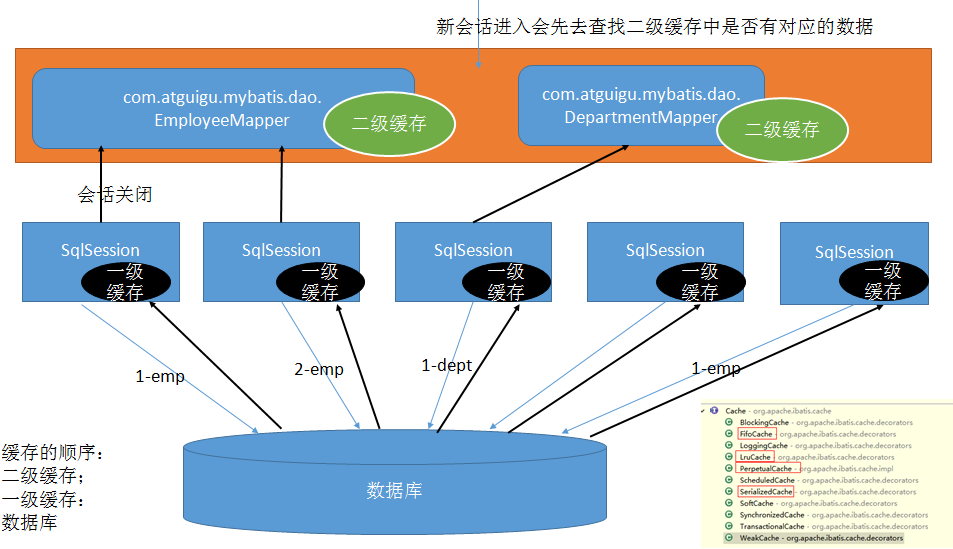一级缓存
一级缓存:(本地缓存):sqlSession级别的缓存。一级缓存是一直开启的;SqlSession级别的一个Map
与数据库同一次会话期间查询到的数据会放在本地缓存中。
以后如果需要获取相同的数据,直接从缓存中拿,没必要再去查询数据库;
一级缓存失效情况(没有使用到当前一级缓存的情况,效果就是,还需要再向数据库发出查询):
1、sqlSession不同。
2、sqlSession相同,查询条件不同.(当前一级缓存中还没有这个数据)
3、sqlSession相同,两次查询之间执行了增删改操作(这次增删改可能对当前数据有影响)
4、sqlSession相同,手动清除了一级缓存(缓存清空)
缓存生效
@Test
public void testFirstLevelCache() throws IOException{
SqlSessionFactory sqlSessionFactory = getSqlSessionFactory();
SqlSession openSession = sqlSessionFactory.openSession();
try{
EmployeeMapper mapper = openSession.getMapper(EmployeeMapper.class);
Employee emp01 = mapper.getEmpById(1);
System.out.println(emp01);
Employee emp02 = mapper.getEmpById(1);
System.out.println(emp02);
System.out.println(emp01==emp02);//true,只发送一条sql
}finally{
openSession.close();
}
}
缓存失效
- sqlSession不同
@Test
public void testFirstLevelCache() throws IOException{
SqlSessionFactory sqlSessionFactory = getSqlSessionFactory();
SqlSession openSession = sqlSessionFactory.openSession();
SqlSession openSession2 = sqlSessionFactory.openSession();
try{
EmployeeMapper mapper = openSession.getMapper(EmployeeMapper.class);
EmployeeMapper mapper2 = openSession2.getMapper(EmployeeMapper.class);
Employee emp01 = mapper.getEmpById(1);
System.out.println(emp01);
Employee emp02 = mapper2.getEmpById(1);
System.out.println(emp02);
System.out.println(emp01==emp02);//false,发送2条sql
}finally{
openSession.close();
openSession2.close();
}
}
- sqlSession相同,查询条件不同.(当前一级缓存中还没有这个数据)
@Test
public void testFirstLevelCache() throws IOException{
SqlSessionFactory sqlSessionFactory = getSqlSessionFactory();
SqlSession openSession = sqlSessionFactory.openSession();
try{
EmployeeMapper mapper = openSession.getMapper(EmployeeMapper.class);
Employee emp01 = mapper.getEmpById(1);
System.out.println(emp01);
Employee emp02 = mapper.getEmpById(2);
System.out.println(emp02);
System.out.println(emp01==emp02);//false,发送2条不同的sql
}finally{
openSession.close();
}
}
- sqlSession相同,两次查询之间执行了增删改操作(这次增删改可能对当前数据有影响)
@Test
public void testFirstLevelCache() throws IOException{
SqlSessionFactory sqlSessionFactory = getSqlSessionFactory();
SqlSession openSession = sqlSessionFactory.openSession();
try{
EmployeeMapper mapper = openSession.getMapper(EmployeeMapper.class);
Employee emp01 = mapper.getEmpById(1);
System.out.println(emp01);
mapper.addEmp(new Employee(null, "testCache", "cache", "1"));
System.out.println("数据添加成功");
Employee emp02 = mapper.getEmpById(2);
System.out.println(emp02);
System.out.println(emp01==emp02);//false,发送2条sql
}finally{
openSession.close();
}
}
- sqlSession相同,手动清除了一级缓存(缓存清空)
@Test
public void testFirstLevelCache() throws IOException{
SqlSessionFactory sqlSessionFactory = getSqlSessionFactory();
SqlSession openSession = sqlSessionFactory.openSession();
try{
EmployeeMapper mapper = openSession.getMapper(EmployeeMapper.class);
Employee emp01 = mapper.getEmpById(1);
System.out.println(emp01);
//缓存清空
openSession.clearCache();
Employee emp02 = mapper.getEmpById(2);
System.out.println(emp02);
System.out.println(emp01==emp02);//false,发送2条sql
}finally{
openSession.close();
}
}
二级缓存
二级缓存:(全局缓存):基于namespace级别的缓存:一个namespace对应一个二级缓存:
工作机制:
1、一个会话,查询一条数据,这个数据就会被放在当前会话的一级缓存中;
2、如果会话关闭;一级缓存中的数据会被保存到二级缓存中;新的会话查询信息,就可以参照二级缓存中的内容;
3、sqlSession===EmployeeMapper==>Employee
DepartmentMapper===>Department
不同namespace查出的数据会放在自己对应的缓存中(map)
效果:数据会从二级缓存中获取
查出的数据都会被默认先放在一级缓存中。
只有会话提交或者关闭以后,一级缓存中的数据才会转移到二级缓存中
使用:
1)、开启全局二级缓存配置:<setting name="cacheEnabled" value="true"/>
2)、去mapper.xml中配置使用二级缓存:
<cache></cache>
3)、我们的POJO需要实现序列化接口
<cache eviction="FIFO" flushInterval="60000" readOnly="false" size="1024"></cache>
<!--
eviction:缓存的回收策略:
• LRU – 最近最少使用的:移除最长时间不被使用的对象。
• FIFO – 先进先出:按对象进入缓存的顺序来移除它们。
• SOFT – 软引用:移除基于垃圾回收器状态和软引用规则的对象。
• WEAK – 弱引用:更积极地移除基于垃圾收集器状态和弱引用规则的对象。
• 默认的是 LRU。
flushInterval:缓存刷新间隔
缓存多长时间清空一次,默认不清空,设置一个毫秒值
readOnly:是否只读:
true:只读;mybatis认为所有从缓存中获取数据的操作都是只读操作,不会修改数据。
mybatis为了加快获取速度,直接就会将数据在缓存中的引用交给用户。不安全,速度快
false:非只读:mybatis觉得获取的数据可能会被修改。
mybatis会利用序列化&反序列的技术克隆一份新的数据给你。安全,速度慢
size:缓存存放多少元素;
type="":指定自定义缓存的全类名;
实现Cache接口即可;
-->
@Test
public void testSecondLevelCache() throws IOException{
SqlSessionFactory sqlSessionFactory = getSqlSessionFactory();
SqlSession openSession = sqlSessionFactory.openSession();
SqlSession openSession2 = sqlSessionFactory.openSession();
try{
//1、
EmployeeMapper mapper = openSession.getMapper(EmployeeMapper.class);
EmployeeMapper mapper2 = openSession2.getMapper(EmployeeMapper.class);
Employee emp01 = mapper.getEmpById(1);
System.out.println(emp01);
openSession.close();
//第二次查询是从二级缓存中拿到的数据,并没有发送新的sql
Employee emp02 = mapper2.getEmpById(1);
System.out.println(emp02);
openSession2.close();
}finally{
}
}
缓存设置
和缓存有关的设置/属性:
1)、cacheEnabled=true:false:关闭缓存(二级缓存关闭)(一级缓存一直可用的)
2)、每个select标签都有useCache="true":
false:不使用缓存(一级缓存依然使用,二级缓存不使用)
3)、【每个增删改标签的:flushCache="true":(一级二级都会清除)】
增删改执行完成后就会清楚缓存;
测试:flushCache="true":一级缓存就清空了;二级也会被清除;
查询标签:flushCache="false":
如果flushCache=true;每次查询之后都会清空缓存;缓存是没有被使用的;
4)、sqlSession.clearCache();只是清楚当前session的一级缓存;
5)、localCacheScope:本地缓存作用域:(一级缓存SESSION);当前会话的所有数据保存在会话缓存中;
STATEMENT:可以禁用一级缓存;
整合ehcache
第三方缓存整合:
1)、导入第三方缓存包即可;
2)、导入与第三方缓存整合的适配包;官方有;
3)、写配合文件:ehcache.xml
4)、mapper.xml中使用自定义缓存
<cache type="org.mybatis.caches.ehcache.EhcacheCache"></cache>
<cache type="org.mybatis.caches.ehcache.EhcacheCache"></cache>
<!-- 引用缓存:namespace:指定和哪个名称空间下的缓存一样 -->
<cache-ref namespace="com.atguigu.mybatis.dao.EmployeeMapper"/>
- ehcache.xml
<?xml version="1.0" encoding="UTF-8"?>
<ehcache xmlns:xsi="http://www.w3.org/2001/XMLSchema-instance"
xsi:noNamespaceSchemaLocation="../config/ehcache.xsd">
<!-- 磁盘保存路径 -->
<diskStore path="D:\44\ehcache" />
<defaultCache
maxElementsInMemory="10000"
maxElementsOnDisk="10000000"
eternal="false"
overflowToDisk="true"
timeToIdleSeconds="120"
timeToLiveSeconds="120"
diskExpiryThreadIntervalSeconds="120"
memoryStoreEvictionPolicy="LRU">
</defaultCache>
</ehcache>
<!--
属性说明:
l diskStore:指定数据在磁盘中的存储位置。
l defaultCache:当借助CacheManager.add("demoCache")创建Cache时,EhCache便会采用<defalutCache/>指定的的管理策略
以下属性是必须的:
l maxElementsInMemory - 在内存中缓存的element的最大数目
l maxElementsOnDisk - 在磁盘上缓存的element的最大数目,若是0表示无穷大
l eternal - 设定缓存的elements是否永远不过期。如果为true,则缓存的数据始终有效,如果为false那么还要根据timeToIdleSeconds,timeToLiveSeconds判断
l overflowToDisk - 设定当内存缓存溢出的时候是否将过期的element缓存到磁盘上
以下属性是可选的:
l timeToIdleSeconds - 当缓存在EhCache中的数据前后两次访问的时间超过timeToIdleSeconds的属性取值时,这些数据便会删除,默认值是0,也就是可闲置时间无穷大
l timeToLiveSeconds - 缓存element的有效生命期,默认是0.,也就是element存活时间无穷大
diskSpoolBufferSizeMB 这个参数设置DiskStore(磁盘缓存)的缓存区大小.默认是30MB.每个Cache都应该有自己的一个缓冲区.
l diskPersistent - 在VM重启的时候是否启用磁盘保存EhCache中的数据,默认是false。
l diskExpiryThreadIntervalSeconds - 磁盘缓存的清理线程运行间隔,默认是120秒。每个120s,相应的线程会进行一次EhCache中数据的清理工作
l memoryStoreEvictionPolicy - 当内存缓存达到最大,有新的element加入的时候, 移除缓存中element的策略。默认是LRU(最近最少使用),可选的有LFU(最不常使用)和FIFO(先进先出)
-->
流程图
